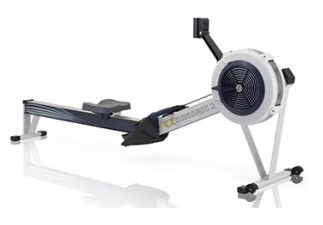The material in this post has been upgraded and expanded in two posts, which describe human energy efficiency at rest and during vigorous exercise.
I first posted “The Inefficiency of Humans” in January 2017. It’s about the reasons that our energy metabolism provides only about 20-25% of the energy we consume as food for muscular work. I referred to this as our “inefficiency”, although it isn’t really that. The explanation and conclusions remain largely unchanged, but since then I’ve learned more about how energy metabolism is measured, so I’ve rewritten the post as this 2.0 version. Much of the original is unchanged.
The human body converts the energy contained in food to mechanical output with an efficiency that may surprise you — it’s that low. Exercise machines at the gym, the ellipticals, stationary bikes, and rowing machines, usually provide readouts that show how much work the user is doing, and how many calories she is burning. Checking the numbers now and then helps pass the time, and may feel rewarding at the end. But if you look at the work done, the power that went into driving the machine, it turns out to be only a fraction, between 18 and 26%, of the total caloric energy burned during the session. (The way to do this comparison is described below.) What’s going on?
Measuring the workout
Most people going to the gym have at least a passing interest in how many calories they have burned. Knowing that may provide at least a faint hope that weight is being lost, even though for most of us, the number of calories consumed during gym workouts is pretty small compared to total food consumption. (As in other posts on this site, I use the term kcal to measure energy. One kcal is 1,000 calories. Food packages provide information in ‘Calories’, capital C calories, which are defined as the same as the kcal, but Calorie has no scientific basis.) The calories burned by the average adult working out fairly strenuously for three hours a week is about 10% of the total energy content of their food. Regular exercise will usually improve health, and may help psychologically with maintaining a healthy life, but real weight loss requires dietary control as well.
Serious athletes such as competitive rowers or cyclists look at a different measurement of their workout’s intensity: they are interested in their “work rate”, which measures how much power they are delivering to the exercise machine. They know that the ability to deliver a high level of power for a longer time is the key to improved performance in almost any sport, but particularly in events like bicycle racing or speed skating. Actually, there’s an even more informative measure for high level participants: the power delivered per kilogram of body weight.
Work rate, or power, is measured in watts, and most workout machines provide that number. A power output of 150 watts for one hour equals 150 watt-hours, or 0.150 kilowatt hours (kWh). This is the measure of how much energy was delivered to the machine. (The kWh is also how the electrical utility measures the energy consumption at your house.) Calories are also a measure of energy, and the units are interconvertible: 1 kWh is the same as 860 kcal.
A workout machine like a stationary bicycle will usually provide both the power being delivered to it (in watts), and the total amount of energy expended by you (in kcal). It may also give you the average power over the time of the training session. But if you compare the power output with the calories burned, there will be a big difference. The number of calories burned will probably be at least four times higher than the power delivered to the machine. What’s going on?
Looking at the numbers
Let’s say, as a reasonably fit adult, one who finds time to work out two or three times a week but has a life, you are comfortable pedaling an exercise bike at a rate of 150 watts for 30 minutes. 150 watts for half an hour is 75 watt-hours, or 0.075 kWh. 150 watts is enough power to keep a few light bulbs going, but your hair dryer may consume energy at ten times that rate. Professional athletes can do far more.
The Belgian bike racer Eddy Merckx is considered by many to be the greatest cyclist who ever lived. He used to annihilate his opponents; his nicknames included “The cannibal” and “One man forest fire”. One day in 1975 he was put on a stationary bicycle and told to go hard. That day, Merckx produced 455 watts of power for one hour, about twice what a fit young amateur athlete can do. Bicycle racers have a phenomanal power to weight ratio. Riders in the peloton can produce 800 watts for 15 seconds, and 600 for one minute. The strongest cyclists can put out 1200 watts for 15 seconds.

Back to your session at the gym. OK, you produced 150 watts for 30 minutes. Now you look at another part of the display and see that it reads 375 kcal burned. Feels good. But wait a minute. From the conversion factor (1 kWh equals 860 kcal) 150 watts for 30 minutes (0.075 kWh) is equal to only 64.5 kcal (.075 x 860). To repeat, what’s going on?
The difference between work done, and the total calories burned, reflects the fact that our bodies don’t convert 100% of the energy released by the consumption of carbohydrate, fat and protein into mechanical work. No machine is 100% efficient, and we are no exception. Cars with internal combustion engines are about 20% efficient at best. The efficiency of the human body, the rate we can do work compared to the calories we burn, is generally between 18 and 26%. (There are many web sites dedicated to explaining the difference. I don’t recommend them. They often get it wrong, and almost always make it even more confusing.)
Human energy metabolism
Energy metabolism is complex, and most people would rather work on their income tax than have someone try to explain it to them. But in simple terms, it helps to think of energy metabolism, the conversion of the energy contained in sugar, fat, and protein into energy usable by the body, as a stream flowing downhill. There are little turbines along the way which harness the energy of the water flowing through them and use it to synthesize adenosine triphosphate, ATP. ATP is the chemical form of energy that the body can use to power its muscles or think its thoughts, among other things (the brain has a high level of energy metabolism; in a body at rest, about 20% of the total).
The products of energy metabolism are carbon dioxide (yes, the greenhouse gas), water, heat, and ATP. The amount of ATP formed is a function of the design of the energy metabolism pathways. As found, in organisms ranging from humans to fruit flies to bacteria, it represents only about 55 – 60% of the energy made available by the path from foodstuff to CO2. If it was designed to extract more energy as ATP, it would be more efficient, but it would run slower, limiting the rate of ATP production. If it was designed to deliver less ATP, less energy captured, the pathway would be faster, but the efficiency would be less. What evolution has provided is a Goldilocks solution: just the right amount of ATP produced, about 57% of the energy of food oxidation captured, so that our normal energy needs are met, without having to pour a lot more fuel into the pathway. (If we were, say, only 10% efficient, we’d have to eat like pandas to provide the energy for our daily lives. Either that, or move like sloths.)
The efficiency of muscular work, driven by ATP, is itself not 100%. Muscle fibers sliding over each other experience friction, like any moving machinery. But the main reason for the “inefficiency” of the human body (not really inefficiency at all) is that many other processes have to keep going to sustain life, and they use energy. Even at rest, when the skeletal muscles are using almost no energy, the human body consumes about 80 watts of energy (65-70 kcal per hour). This keeps the heart going, the blood flowing, and the lungs inhaling and exhaling. A lot of energy is required to keep the right level of ions like sodium in cells. And then there’s the repair. Damaged molecules and cells are constantly being replaced. The cells of the gut, for example, only last on average 4 days, and by then new cell have to be available.
Nothing runs without energy, and during intense work, everything works harder. (Even repair. Dark color in the urine after a marathon is probably due to red blood cells that were destroyed by the pounding of the feet on pavement.) At full tilt, the heart rate may be three times the resting rate, and the lungs puff faster and harder. All of these things are machines that require ATP as a power source. So, not only is the production of ATP by metabolic pathways only about 55-60% efficient, that ATP is shared between the muscles driving the athletic activity and other activities necessary to keep us alive. The result is that only about 18-26% of the energy content of that chocolate bar you ate shows up as work output powering the stationary bike or rowing machine. The rest is heat. (When Eddy Merckx performed his epic work rate on a stationary bike, he had to have fans blowing air over him to keep from overheating — he was probably generating about 1,900 watts, or 1,600 kcal per hour, of heat. You could sear a steak. Seriously.)
Making sense of the numbers
At the gym, the power output of your exercise machine is a hard number, measured directly by the force applied to the pedals. It’s the work actually done. The total calories burned, on the other hand, is a calculated number, obtained by dividing the power output by your estimated efficiency. This is necessary because measuring the Calories expended directly is a bit of a science project, and can’t be done on your exercise bike. The non-intrusive method used today, called the “Doubly Labeled Water” (DLW) method, involves doping the body with water containing the heavy isotopes deuterium (2H) and 18O. The rate of excretion of this heavy water, together with some other data, is then used to calculate the total energy consumption. The DLW technique measures the total energy burned over a period of days or weeks, not minutes. It has been used extensively to monitor energy intake and expenditure in bicycle races such as the Tour de France, to see whether riders are taking in enough nutrients to keep them going. The numbers are eye-popping: a Tour rider may take in as much as 8,000 kcal a day and still be losing weight during several highly challenging stages of the race.
The DLW technique involves some estimations: for example, the total calories expended are measured over a period of several days, and corrections have to be made for energy burned during the non-race hours. But the number obtained for total energy consumed while racing is undoubtedly very close to accurate.
Bikes can be equipped with special hubs or pedals to allow them to measure the power delivered, so the efficiency, the ratio of power delivered to total energy consumed, can be determined. The results for high-intensity bicycle road races have led to the number 24%; in a Tour de France racer, 24% of the energy consumed is delivered to the pedals. This is the efficiency. The net efficiencies of competitive rowers has been reported to be 27.5% (Fukunaga et al., Eur. J. Appl. Physiol. Occup. Physiol. 55(5):471, 1986).
The calculation of calories expended on your stationary bike depends on what value the machine’s computer uses for the efficiency factor: how much of the total metabolic energy output that you produced actually drove the pedals? In the present example (150 watts for 30 minutes, equal to 64.5 Calories of actual work done), if we use an efficiency factor of 22%, which is a reasonable value for a healthy young adult, the total energy would be 64.5/.22 + 50 (50 is a half-hour’s worth of basal energy consumption while you’re awake), or 343 kcal. Your readout should be somewhere in that neighbourhood.
Heavier people are generally less efficient than lighter ones, and some machines ask for your weight and adjust the efficiency in calculating caloric output. Some don’t. But there are no absolute numbers for a given weight and work rate, so the total energy output (Calories burned) is an estimate. There’s not much you can do about your energy efficiency, beyond losing some pounds if you’re overweight.
I determined the calories burned and the power expended on an elliptical machine in my gym recently. What I observed was an apparent efficiency that varied with body weight and exercise intensity (from 100 to 300 watts). When I dialed in a very low body weight, the machine used a higher efficiency factor than if I dialed in a much higher body weight. That’s reasonable: an overweight person has more body to service than a lean person. And if I worked at a low power, the efficiency was also lower, compared to a high rate of power. That’s also entirely reasonable; at rest, very little of the total energy consumed is going to drive the pedals, most of it is being used to keep me alive. Judging by the ratios between power produced (watts) and total energy consumed (kcal), the efficiency values used by the machine ranged between 18 and 23%.
According to online exercise geeks, some makers of workout machines inflate the numbers produced by their machines. A sales gimmick: wouldn’t you rather work out on a machine that says you expended 400 kcal, rather than 300, for the level of effort reflected by heart rate and the feeling of exhaustion? If you are buying a machine for home use, you might prefer a machine that, based on your experience at the gym, indicated a higher expenditure of calories for a given level of effort on your part. Caveat emptor.





Your style is really unique in comparison to other people I’ve read stuff from. Thanks for posting when you’ve got the opportunity, Guess I will just book mark this site.
continuing education http://www.educationhints.eu
I’m not sure where you are getting your information, but good topic. I needs to spend some time learning much more or understanding more. Thanks for fantastic info I was looking for this information for my mission.
starting your own business
http://www.dealhint.eu
Thanks. As for where the information comes from, it’s what happens to old brains – they fill up with information, or at least, with a list of topics that can be looked up.
“Great blog here! Also your website loads up fast! What web host are you using? Can I get your affiliate link to your host? I wish my site loaded up as quickly as yours lol”
I am using a really simple theme, “tdMinimal”, from the developer Taras Dashkevych.
Looking forward to reading more. Great post.Thanks Again. Awesome.
Major thankies for the article post.Thanks Again. Want more.
A round of applause for your blog article.Really thank you! Really Great.
Im thankful for the article post.Much thanks again. Really Great.
Really informative article post.Really looking forward to read more. Fantastic.
I cannot thank you enough for the blog post.Thanks Again. Really Cool.
Fantastic blog article.Really thank you! Will read on…
This is one awesome article post. Really Great.
Enjoyed every bit of your article.
I loved your article post. Great.
Im obliged for the article post.Much thanks again. Keep writing.
Awesome blog post.Really looking forward to read more. Awesome.
It’s a pity you don’t have a donate button! I’d most certainly
donate to this superb blog! I guess for now i’ll settle for bookmarking and adding your RSS feed to my
Google account. I look forward to brand new updates and will talk about
this blog with my Facebook group. Talk soon!
I’m gone to inform my little brother, that he should also pay a visit this webpage on regular basis to take updated from
most up-to-date reports.
I’ve been browsing online greater than three hours as of late, yet I never discovered any fascinating article like yours.
It’s pretty price enough for me. In my opinion, if all web owners and bloggers made excellent content as you did, the web will probably be much more useful than ever before.
I have been surfing online more than 3 hours today, yet I never found any interesting article like yours.
It’s pretty worth enough for me. In my opinion, if all webmasters
and bloggers made good content as you did, the internet will be
a lot more useful than ever before.
Excellent post. I used to be checking constantly this weblog
and I’m impressed! Extremely helpful info particularly the final phase :
) I care for such info much. I used to be seeking this certain information for a very long time.
Thanks and best of luck.
always i used to read smaller posts that as
well clear their motive, and that is also happening with this article which I
am reading here.
I got this site from my friend who informed me about this website and
now this time I am visiting this website and reading very informative
articles at this time.
Hi Dear, are you genuinely visiting this website daily, if
so afterward you will without doubt take nice knowledge.
Hello There. I found your blog using msn. This is an extremely well written article.
I’ll be sure to bookmark it and return to read more of your useful information. Thanks for the post.
I’ll definitely comeback.
Excellent blog post. I definitely love this site.
Keep writing!
My partner and I stumbled over here by a different page and thought I may as well check things out.
I like what I see so now i am following you.
Look forward to checking out your web page repeatedly.
What’s up everyone, it’s my first pay a quick visit at this web site, and post is actually
fruitful designed for me, keep up posting such articles or reviews.
Asking questions are in fact nice thing if you are not understanding anything entirely, however this article provides fastidious understanding even.
What’s up colleagues, how is the whole thing, and what you
would like to say about this article, in my view its genuinely amazing in support of me.
Wow! At last I got a website from where I know how to really get valuable data regarding my
study and knowledge.
If you desire to increase your familiarity only keep visiting
this web page and be updated with the latest news update posted here.
That is a very good tip especially to those fresh to the blogosphere.
Short but very precise information… Many thanks for sharing this one.
A must read post!
I am no longer certain the place you’re getting your
information, but great topic. I needs to spend some time studying much more or figuring
out more. Thank you for excellent information I was searching for this information for my mission.
I appreciate, cause I discovered exactly what I was looking for.
You have ended my four day lengthy hunt! God Bless
you man. Have a great day. Bye
Its like you read my mind! You appear to know a lot about this,
like you wrote the book in it or something. I think that you
can do with a few pics to drive the message home a bit,
but instead of that, this is wonderful blog.
An excellent read. I will certainly be back.
Excellent goods from you, man. I’ve understand your stuff previous to and you are just too excellent.
I really like what you have acquired here, certainly like
what you’re saying and the way in which you say it.
You make it entertaining and you still take care of to keep
it wise. I can not wait to read far more from
you. This is actually a wonderful website.
Heya i am for the first time here. I came across this board
and I find It really useful & it helped me out much.
I hope to give something back and help others like you aided me.
Do you have a spam issue on this blog; I also am a blogger, and
I was wanting to know your situation; many of us have developed some nice
methods and we are looking to swap strategies with others,
be sure to shoot me an email if interested.
Yeah, I have these people who post dozens of messages on my site, nothing to do with the content. Do we call that spam? I know there are plugins that block spam, and I’ve just engaged one. See if it helps. A real pain.
Heya i’m for the first time here. I came across this board and I find
It truly useful & it helped me out much. I hope to give something back and
aid others like you aided me.
Howdy terrific blog! Does running a blog such as this require a massive amount work?
I’ve virtually no understanding of coding however
I had been hoping to start my own blog in the near future.
Anyhow, should you have any ideas or techniques for new blog owners please share.
I know this is off subject but I just had to ask.
Cheers!
A fair amount. About one a month is all I can put together. Any ideas about future topics I should hit?
Hey there! I’ve been following your weblog for some time now and finally got the courage to
go ahead and give you a shout out from Kingwood Texas!
Just wanted to mention keep up the great job!
“Thanks a lot for the post.Really thank you! Will read on…”